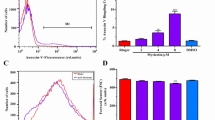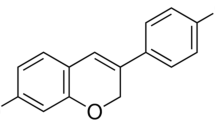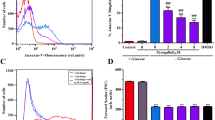Abstract
Hexavalent (VI) chromium is a global contaminant with cytotoxic activity. Chromium (VI) induces oxidative stress, inflammation, cell proliferation, malignant transformation and may trigger carcinogenesis and at the same time apoptosis. The toxic effects of chromium (VI) at least partially result from mitochondrial injury and DNA damage. Erythrocytes lack mitochondria and nuclei but may experience an apoptosis-like suicidal cell death, i.e. eryptosis, which is characterized by cell shrinkage and cell membrane scrambling with phosphatidylserine exposure at the cell surface. Eryptosis may result from increase of cytosolic Ca2+ activity, ATP depletion and/or ceramide formation. The present study explored, whether chromium (VI) triggers eryptosis. Fluo-3-fluorescence was employed to determine cytosolic Ca2+-concentration, forward scatter to estimate cell volume, binding of fluorescent annexin V to detect phosphatidylserine exposure, hemoglobin concentration in the supernatant to quantify hemolysis, luciferin–luciferase to determine cytosolic ATP concentration and fluorescent anti-ceramide antibodies to uncover ceramide formation. A 48 h exposure to chromium (VI) (≥10 μM) significantly increased cytosolic Ca2+-concentration, decreased ATP concentration (20 μM), decreased forward scatter, increased annexin V-binding and increased (albeit to a much smaller extent) hemolysis. Chromium (VI) did not significantly modify ceramide formation. The effect of 20 μM chromium (VI) on annexin V binding was partially reversed in the nominal absence of Ca2+. The present observations disclose a novel effect of chromium (VI), i.e. Ca2+ entry and cytosolic ATP depletion in erythrocytes, effects resulting in eryptosis with cell shrinkage and cell membrane scrambling.





Similar content being viewed by others
References
Andrews DA, Low PS (1999) Role of red blood cells in thrombosis. Curr Opin Hematol 6:76–82
Asatiani N, Abuladze M, Kartvelishvili T, Kulikova N, Asanishvili L, Holman HY, Sapojnikova N (2010) Response of antioxidant defense system to chromium (VI)-induced cytotoxicity in human diploid cells. Biometals 23:161–172
Berg CP, Engels IH, Rothbart A, Lauber K, Renz A, Schlosser SF, Schulze-Osthoff K, Wesselborg S (2001) Human mature red blood cells express caspase-3 and caspase-8, but are devoid of mitochondrial regulators of apoptosis. Cell Death Differ 8:1197–1206
Bhavsar SK, Bobbala D, Xuan NT, Foller M, Lang F (2010a) Stimulation of suicidal erythrocyte death by alpha-lipoic acid. Cell Physiol Biochem 26:859–868
Bhavsar SK, Eberhard M, Bobbala D, Lang F (2010b) Monensin induced suicidal erythrocyte death. Cell Physiol Biochem 25:745–752
Birka C, Lang PA, Kempe DS, Hoefling L, Tanneur V, Duranton C, Nammi S, Henke G, Myssina S, Krikov M, Huber SM, Wieder T, Lang F (2004) Enhanced susceptibility to erythrocyte “apoptosis” following phosphate depletion. Pflugers Arch 448:471–477
Bobbala D, Alesutan I, Foller M, Huber SM, Lang F (2010) Effect of anandamide in Plasmodium berghei-infected mice. Cell Physiol Biochem 26:355–362
Bookchin RM, Ortiz OE, Lew VL (1987) Activation of calcium-dependent potassium channels in deoxygenated sickled red cells. Prog Clin Biol Res 240:193–200
Brand VB, Sandu CD, Duranton C, Tanneur V, Lang KS, Huber SM, Lang F (2003) Dependence of Plasmodium falciparum in vitro growth on the cation permeability of the human host erythrocyte. Cell Physiol Biochem 13:347–356
Bratosin D, Estaquier J, Petit F, Arnoult D, Quatannens B, Tissier JP, Slomianny C, Sartiaux C, Alonso C, Huart JJ, Montreuil J, Ameisen JC (2001) Programmed cell death in mature erythrocytes: a model for investigating death effector pathways operating in the absence of mitochondria. Cell Death Differ 8:1143–1156
Braun M, Foller M, Gulbins E, Lang F (2009) Eryptosis triggered by bismuth. Biometals 22:453–460
Brugnara C, de Franceschi L, Alper SL (1993) Inhibition of Ca(2+)-dependent K+ transport and cell dehydration in sickle erythrocytes by clotrimazole and other imidazole derivatives. J Clin Invest 92:520–526
Burdmann EA, Woronik V, Prado EB, Abdulkader RC, Saldanha LB, Barreto OC, Marcondes M (1993) Snakebite-induced acute renal failure: an experimental model. Am J Trop Med Hyg 48:82–88
Calderon-Salinas JV, Munoz-Reyes EG, Guerrero-Romero JF, Rodriguez-Moran M, Bracho-Riquelme RL, Carrera-Gracia MA, Quintanar-Escorza MA (2011) Eryptosis and oxidative damage in type 2 diabetic mellitus patients with chronic kidney disease. Mol Cell Biochem 357:171–179
Chernecky CC, Berger BJ (1997) Laboratory tests and diagnostic procedures. Saunders, Philadelphia
Chiu A, Shi XL, Lee WK, Hill R, Wakeman TP, Katz A, Xu B, Dalal NS, Robertson JD, Chen C, Chiu N, Donehower L (2010) Review of chromium (VI) apoptosis, cell-cycle-arrest, and carcinogenesis. J Environ Sci Health C Environ Carcinog Ecotoxicol Rev 28:188–230
Chung SM, Bae ON, Lim KM, Noh JY, Lee MY, Jung YS, Chung JH (2007) Lysophosphatidic acid induces thrombogenic activity through phosphatidylserine exposure and procoagulant microvesicle generation in human erythrocytes. Arterioscler Thromb Vasc Biol 27:414–421
Closse C, Dachary-Prigent J, Boisseau MR (1999) Phosphatidylserine-related adhesion of human erythrocytes to vascular endothelium. Br J Haematol 107:300–302
Das AP, Singh S (2011) Occupational health assessment of chromite toxicity among Indian miners. Indian J Occup Environ Med 15:6–13
Eberhard M, Ferlinz K, Alizzi K, Cacciato PM, Faggio C, Foller M, Lang F (2010) FTY720-induced suicidal erythrocyte death. Cell Physiol Biochem 26:761–766
Fernandez-Minano E, Ortiz C, Vicente A, Calvo JL, Ortiz AJ (2011) Metallic ion content and damage to the DNA in oral mucosa cells of children with fixed orthodontic appliances. Biometals 24:935–941
Foller M, Kasinathan RS, Koka S, Lang C, Shumilina E, Birnbaumer L, Lang F, Huber SM (2008) TRPC6 contributes to the Ca(2+) leak of human erythrocytes. Cell Physiol Biochem 21:183–192
Foller M, Bobbala D, Koka S, Huber SM, Gulbins E, Lang F (2009a) Suicide for survival–death of infected erythrocytes as a host mechanism to survive malaria. Cell Physiol Biochem 24:133–140
Foller M, Sopjani M, Koka S, Gu S, Mahmud H, Wang K, Floride E, Schleicher E, Schulz E, Munzel T, Lang F (2009b) Regulation of erythrocyte survival by AMP-activated protein kinase. FASEB J 23:1072–1080
Gallagher PG, Chang SH, Rettig MP, Neely JE, Hillery CA, Smith BD, Low PS (2003) Altered erythrocyte endothelial adherence and membrane phospholipid asymmetry in hereditary hydrocytosis. Blood 101:4625–4627
Ghashghaeinia M, Toulany M, Saki M, Bobbala D, Fehrenbacher B, Rupec R, Rodemann HP, Ghoreschi K, Rocken M, Schaller M, Lang F, Wieder T (2011) The NFkB pathway inhibitors Bay 11-7082 and parthenolide induce programmed cell death in anucleated erythrocytes. Cell Physiol Biochem 27:45–54
Hartwig A (1995) Current aspects in metal genotoxicity. Biometals 8:3–11
Hedberg Y, Hedberg J, Liu Y, Wallinder IO (2011) Complexation- and ligand-induced metal release from 316L particles: importance of particle size and crystallographic structure. Biometals, in press
Holmes AL, Wise SS, Wise JP Sr (2008) Carcinogenicity of hexavalent chromium. Indian J Med Res 128:353–372
Kempe DS, Lang PA, Duranton C, Akel A, Lang KS, Huber SM, Wieder T, Lang F (2006) Enhanced programmed cell death of iron-deficient erythrocytes. FASEB J 20:368–370
Kempe DS, Akel A, Lang PA, Hermle T, Biswas R, Muresanu J, Friedrich B, Dreischer P, Wolz C, Schumacher U, Peschel A, Gotz F, Doring G, Wieder T, Gulbins E, Lang F (2007) Suicidal erythrocyte death in sepsis. J Mol Med 85:273–281
Klarl BA, Lang PA, Kempe DS, Niemoeller OM, Akel A, Sobiesiak M, Eisele K, Podolski M, Huber SM, Wieder T, Lang F (2006) Protein kinase C mediates erythrocyte “programmed cell death” following glucose depletion. Am J Physiol Cell Physiol 290:C244–C253
Koka S, Bobbala D, Lang C, Boini KM, Huber SM, Lang F (2009) Influence of paclitaxel on parasitemia and survival of Plasmodium berghei infected mice. Cell Physiol Biochem 23:191–198
Kornhuber J, Tripal P, Reichel M, Muhle C, Rhein C, Muehlbacher M, Groemer TW, Gulbins E (2010) Functional Inhibitors of Acid Sphingomyelinase (FIASMAs): a novel pharmacological group of drugs with broad clinical applications. Cell Physiol Biochem 26:9–20
Lang F, Busch GL, Ritter M, Volkl H, Waldegger S, Gulbins E, Haussinger D (1998) Functional significance of cell volume regulatory mechanisms. Physiol Rev 78:247–306
Lang KS, Duranton C, Poehlmann H, Myssina S, Bauer C, Lang F, Wieder T, Huber SM (2003a) Cation channels trigger apoptotic death of erythrocytes. Cell Death Differ 10:249–256
Lang PA, Kaiser S, Myssina S, Wieder T, Lang F, Huber SM (2003b) Role of Ca2+-activated K+ channels in human erythrocyte apoptosis. Am J Physiol Cell Physiol 285:C1553–C1560
Lang KS, Myssina S, Brand V, Sandu C, Lang PA, Berchtold S, Huber SM, Lang F, Wieder T (2004) Involvement of ceramide in hyperosmotic shock-induced death of erythrocytes. Cell Death Differ 11:231–243
Lang PA, Kempe DS, Tanneur V, Eisele K, Klarl BA, Myssina S, Jendrossek V, Ishii S, Shimizu T, Waidmann M, Hessler G, Huber SM, Lang F, Wieder T (2005) Stimulation of erythrocyte ceramide formation by platelet-activating factor. J Cell Sci 118:1233–1243
Lang PA, Beringer O, Nicolay JP, Amon O, Kempe DS, Hermle T, Attanasio P, Akel A, Schafer R, Friedrich B, Risler T, Baur M, Olbricht CJ, Zimmerhackl LB, Zipfel PF, Wieder T, Lang F (2006) Suicidal death of erythrocytes in recurrent hemolytic uremic syndrome. J Mol Med 84:378–388
Lang PA, Schenck M, Nicolay JP, Becker JU, Kempe DS, Lupescu A, Koka S, Eisele K, Klarl BA, Rubben H, Schmid KW, Mann K, Hildenbrand S, Hefter H, Huber SM, Wieder T, Erhardt A, Haussinger D, Gulbins E, Lang F (2007) Liver cell death and anemia in Wilson disease involve acid sphingomyelinase and ceramide. Nat Med 13:164–170
Lang F, Gulbins E, Lerche H, Huber SM, Kempe DS, Foller M (2008) Eryptosis, a window to systemic disease. Cell Physiol Biochem 22:373–380
Lang PA, Kasinathan RS, Brand VB, Duranton C, Lang C, Koka S, Shumilina E, Kempe DS, Tanneur V, Akel A, Lang KS, Foller M, Kun JF, Kremsner PG, Wesselborg S, Laufer S, Clemen CS, Herr C, Noegel AA, Wieder T, Gulbins E, Lang F, Huber SM (2009) Accelerated clearance of Plasmodium-infected erythrocytes in sickle cell trait and annexin-A7 deficiency. Cell Physiol Biochem 24:415–428
Lang F, Gulbins E, Lang PA, Zappulla D, Foller M (2010) Ceramide in suicidal death of erythrocytes. Cell Physiol Biochem 26:21–28
Maellaro E, Leoncini S, Moretti D, Del Bello B, Tanganelli I, De Felice C, Ciccoli L (2011) Erythrocyte caspase-3 activation and oxidative imbalance in erythrocytes and in plasma of type 2 diabetic patients. Acta Diabetol, in press
Mahmud H, Foller M, Lang F (2009a) Arsenic-induced suicidal erythrocyte death. Arch Toxicol 83:107–113
Mahmud H, Mauro D, Foller M, Lang F (2009b) Inhibitory effect of thymol on suicidal erythrocyte death. Cell Physiol Biochem 24:407–414
Mahmud H, Mauro D, Qadri SM, Foller M, Lang F (2009c) Triggering of suicidal erythrocyte death by amphotericin B. Cell Physiol Biochem 24:263–270
Mandal D, Moitra PK, Saha S, Basu J (2002) Caspase 3 regulates phosphatidylserine externalization and phagocytosis of oxidatively stressed erythrocytes. FEBS Lett 513:184–188
McCarroll N, Keshava N, Chen J, Akerman G, Kligerman A, Rinde E (2010) An evaluation of the mode of action framework for mutagenic carcinogens case study II: chromium (VI). Environ Mol Mutagen 51:89–111
Meyskens FL, Yang S (2011) Thinking about the role (largely ignored) of heavy metals in cancer prevention: hexavalent chromium and melanoma as a case in point. Recent Results Cancer Res 188:65–74
Myssina S, Huber SM, Birka C, Lang PA, Lang KS, Friedrich B, Risler T, Wieder T, Lang F (2003) Inhibition of erythrocyte cation channels by erythropoietin. J Am Soc Nephrol 14:2750–2757
Nickens KP, Patierno SR, Ceryak S (2010) Chromium genotoxicity: a double-edged sword. Chem Biol Interact 188:276–288
Nicolay JP, Schneider J, Niemoeller OM, Artunc F, Portero-Otin M, Haik G Jr, Thornalley PJ, Schleicher E, Wieder T, Lang F (2006) Stimulation of suicidal erythrocyte death by methylglyoxal. Cell Physiol Biochem 18:223–232
Oze C, Bird DK, Fendorf S (2007) Genesis of hexavalent chromium from natural sources in soil and groundwater. Proc Natl Acad Sci USA 104:6544–6549
Pandolfi A, Di Pietro N, Sirolli V, Giardinelli A, Di Silvestre S, Amoroso L, Di Tomo P, Capani F, Consoli A, Bonomini M (2007) Mechanisms of uremic erythrocyte-induced adhesion of human monocytes to cultured endothelial cells. J Cell Physiol 213:699–709
Pereira MC, Pereira ML, Sousa JP (1999) Individual study of chromium in the stainless steel implants degradation: an experimental study in mice. Biometals 12:275–280
Ramirez-Diaz MI, Diaz-Perez C, Vargas E, Riveros-Rosas H, Campos-Garcia J, Cervantes C (2008) Mechanisms of bacterial resistance to chromium compounds. Biometals 21:321–332
Reubi FC (1978) Pathogenesis and renal function in acute toxic nephropathies. Contrib Nephrol 10:1–14
Schiffl H, Weidmann P, Weiss M, Massry SG (1982) Dialysis treatment of acute chromium intoxication and comparative efficacy of peritoneal versus hemodialysis in chromium removal. Miner Electrolyte Metab 7:28–35
Siraskar B, Ballal A, Bobbala D, Foller M, Lang F (2010) Effect of amphotericin B on parasitemia and survival of Plasmodium berghei-infected mice. Cell Physiol Biochem 26:347–354
Stout MD, Herbert RA, Kissling GE, Collins BJ, Travlos GS, Witt KL, Melnick RL, Abdo KM, Malarkey DE, Hooth MJ (2009) Hexavalent chromium is carcinogenic to F344/N rats and B6C3F1 mice after chronic oral exposure. Environ Health Perspect 117:716–722
Thompson CM, Haws LC, Harris MA, Gatto NM, Proctor DM (2011) Application of the U.S. EPA mode of action Framework for purposes of guiding future research: a case study involving the oral carcinogenicity of hexavalent chromium. Toxicol Sci 119:20–40
Velma V, Vutukuru SS, Tchounwou PB (2009) Ecotoxicology of hexavalent chromium in freshwater fish: a critical review. Rev Environ Health 24:129–145
Wise SS, Holmes AL, Wise JP Sr (2008) Hexavalent chromium-induced DNA damage and repair mechanisms. Rev Environ Health 23:39–57
Wood BL, Gibson DF, Tait JF (1996) Increased erythrocyte phosphatidylserine exposure in sickle cell disease: flow-cytometric measurement and clinical associations. Blood 88:1873–1880
Yao H, Guo L, Jiang BH, Luo J, Shi X (2008) Oxidative stress and chromium(VI) carcinogenesis. J Environ Pathol Toxicol Oncol 27:77–88
Zappulla D (2008) Environmental stress, erythrocyte dysfunctions, inflammation, and the metabolic syndrome: adaptations to CO2 increases? J Cardiometab Syndr 3:30–34
Zwaal RF, Comfurius P, Bevers EM (2005) Surface exposure of phosphatidylserine in pathological cells. Cell Mol Life Sci 62:971–988
Acknowledgments
The authors acknowledge the meticulous preparation of the manuscript by Sari Rübe. This study was supported by the Deutsche Forschungsgemeinschaft.
Author information
Authors and Affiliations
Corresponding author
Additional information
Adrian Lupescu and Kashif Jilani contributed equally and thus share the first authorship.
Rights and permissions
About this article
Cite this article
Lupescu, A., Jilani, K., Zelenak, C. et al. Hexavalent chromium-induced erythrocyte membrane phospholipid asymmetry. Biometals 25, 309–318 (2012). https://doi.org/10.1007/s10534-011-9507-5
Received:
Accepted:
Published:
Issue Date:
DOI: https://doi.org/10.1007/s10534-011-9507-5




